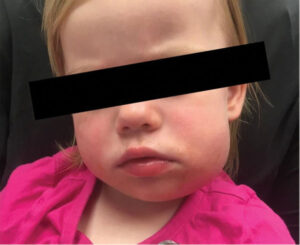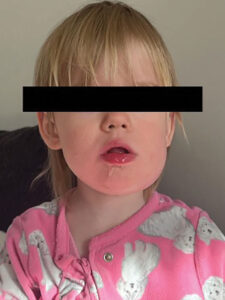
Identifying the etiology of acute facial swelling in children can be a challenge due to growth and development, complex regional anatomy, and difficulty with obtaining a thorough history. We present a case report from rural Alberta that highlights these challenges. In particular, this case demonstrates the necessity for open communication with the child’s family and team of physicians to facilitate appropriate and efficient care.
Case Report
A 12-month old female presented to the general dentist with significant facial swelling on the lower left. The mother reported that the child had an unwitnessed fall at daycare earlier that day, and the swelling developed quite rapidly according to the daycare attendant. Initially, the child was seen by a family physician in a nearby town, and the physician ordered a radiograph of the child’s jaw, which was unremarkable. No one looked in the child’s mouth; furthermore, the child was not prescribed any medication following her visit with the physician.
Physical examination revealed significant swelling across the body of the left mandible extending to the angle. (Fig. 1 & Fig. 2) The dentist could palpate the mandible, and there were no step defects, bruises or other signs of trauma. Dental examination revealed an otherwise healthy, incomplete primary dentition. The child did not cooperate for intraoral radiographs.
Fig. 1

Fig. 2

Given the acute nature of the swelling and concern for infection, the dentist discharged the child with a prescription for amoxicillin, and encouraged the mother to follow up with the family physician.
The dentist called the family later that evening, and the mother reported that the swelling appeared to be spreading closer to the midline. (Fig. 3) She still had not heard from the family physician, but did fill the prescription provided by the dentist. At this point, the dentist encouraged the family to report to the local hospital to be evaluated by an emergency physician.
Fig. 3

Ahead of their visit, the dentist contacted the emergency department and explained the urgency of the matter. The dentist described the acute nature of the swelling and the events of the day. The swelling was not likely secondary to a dental infection or trauma.
The child reported to the emergency department where the physician conducted their evaluation and ordered bloodwork in addition to an ultrasound scan of the swelling. The bloodwork revealed an elevated white blood cell count, and the ultrasound depicted multiple enlarged lymph nodes around the left mandible. The child was discharged that same evening, and the physician encouraged the family to continue with the amoxicillin prescribed by the dentist. There was still no official diagnosis, and the family was encouraged to follow up in six weeks.
The mother called the dentist in the morning still quite anxious with the lack of diagnosis or any definitive plan. Appreciating the mother’s concerns, the dentist advised the family to go to the emergency department at the Stollery Children’s Hospital in Edmonton, Alberta. Upon arrival at the Stollery, the child’s temperature was 38.4 degrees Celsius. The emergency physician ordered bloodwork, obtained a serum test for infectious mononucleosis, and started the child on intravenous ceftriaxone. Again, the bloodwork revealed elevated white blood cells, and the test for mononucleosis was negative.
The Department of Otolaryngology was also consulted, and the surgeon advised an open and drain of the neck swelling. The child was admitted to the hospital, and no additional imaging was obtained prior to the surgery. The following day, the child was taken to the operating theatre, and the swelling was incised, drained and cultured. The results of the culture were positive Staphylococcus aureus resistant to Clindamycin. The child continued on intravenous ceftriaxone for another day, and was discharged with oral antibiotics. The swelling subsided, and the child recovered. She was seen by the head and neck surgeon two months later for follow up with no significant report.
Discussion
Facial swelling in adults is often the result of odontogenic infection. In children, the source of the infection can be more challenging to discern with both odontogenic and non-odontogenic contributors.1,2 The spectrum is wide and can include traumatic, inflammatory and neoplastic etiologies. In general, when a child presents to the dental office with a facial swelling that is not clearly linked to recent trauma or odontogenic infection, it is important for the dentist to refer the child to a family physician or pediatrician for further evaluation. Furthermore, if the swelling is significant, the dentist must encourage the family to take the child to an emergency department for more expedient care. Unmanaged acute infections in children can quickly progress to high fever, dehydration and sepsis.
Conclusion
When a child reports to the dental office with an acute facial swelling of unknown etiology, it is important for the dentist to communicate this with the child’s physician or pediatrician. This case highlights the role of the general dentist as an advocate for the overall health and wellbeing of his patient.
Oral Health welcomes this original article.
References
- Yeung, D. Y., & Vachani, J. G. (2013). One approach to facial swelling: tooth or fiction. Hospital Pediatrics, 3(1), 70-73.
- Khanna, G., Sato, Y., Smith, R. J. H., Bauman, N. M., & Nerad, J. (2006). Causes of facial swellings in pediatric patients: correlation of clinical and radiographic findings. RadioGraphics, 26(1), 157-71.
About the Author:

Dr. Akberali K. Ebrahim completed his Doctor of Dental Surgery at the University of Alberta. Currently, he is the owner of rural Alberta dental practices. Dr. Ebrahim provides a comprehensive approach to dental treatment with a passion for oral surgery and pediatric dentistry, as well as providing after-hours care and oral and nitrous sedation to his patients. Akberali would like to thank Dr. Darsi Perusini for his assistance with the preparation of this article.

Dr. Darsi Perusini is a pediatric dentist in Edmonton, Alberta, and is a part-time clinical instructor and lecturer in the Department of Pediatric Dentistry at the University of Alberta.









